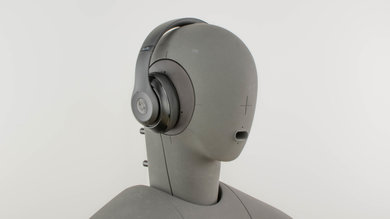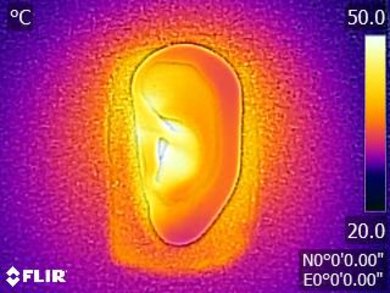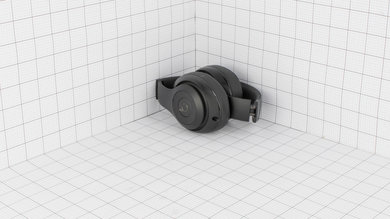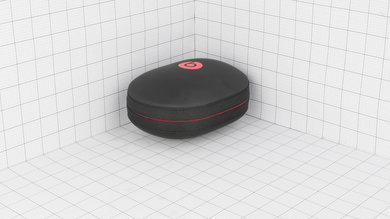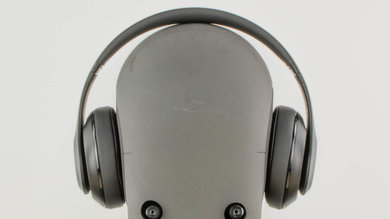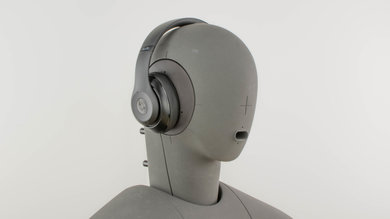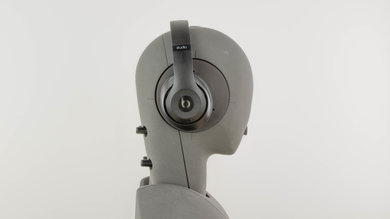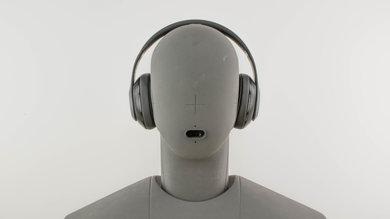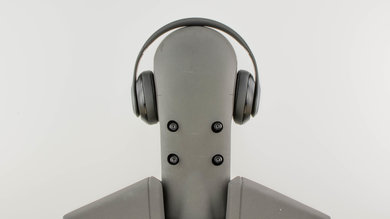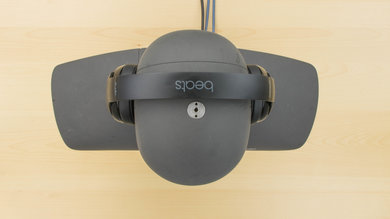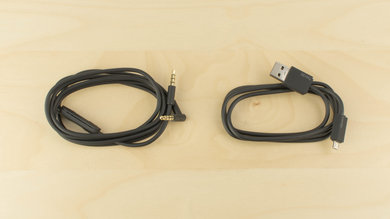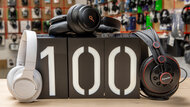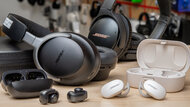Our Verdict
The Beats Studio Wireless are an above-average pair of mixed usage headphones. They're sleek yet durable. They're comfortable and relatively compact for an over-ear model. They make decent sports headphones, and their sound is also good enough for recording and casual listening. However, they don't isolate enough for noisy commutes and loud environments.
- Comfortable and stable fit.
- Slick and sturdy wireless design.
- Low leakage.
- Poor noise isolation.
Above-average for neutral listening. They have a good audio reproduction that's balanced and punchy enough for most listeners. However, they lack a little soundstage due to their comparatively small and closed ear cups.
Decent for commuting. They have a sleek wireless design that's not too cumbersome to use or carry around. However, the weak noise canceling alone is not sufficient for the ambient noise of a bus or train ride.
Above-average for sports use. The Beats Studio Wireless have comfortable and stable wireless design with a decent control scheme. However, although relatively compact for an over-ear model, they're still full-sized headphones that will sway and get steamy during intense workouts.
Suitable for office use. They will let some of the chatter, seep into your audio, but they don't leak much. So you can listen at higher volumes and mask some of the ambient noise.
Below-average for gaming. The Beats Studio Wireless are comfortable, have a great range, and easy to use controls but the latency will be a deal breaker for most. They also have no customizable options and a mediocre at best microphone.
Changelog
- Updated Nov 21, 2019: Converted to Test Bench 1.3.1.
- Updated Nov 21, 2019: Converted to Test Bench 1.3.
- Updated Feb 16, 2018: Converted to Test Bench 1.2.
- Updated Sep 28, 2017: The microphone has been tested with our new methodology, as explained here
Check Price
Popular Headphones Comparisons

The Beats Studio are well-designed and comfortable over wireless headphones. They have a slick build quality that feels decently durable and is stable enough for running but won't be ideal for more intense sports. They also have an above average frequency response that delivers a good amount of bass without being overpowering like some of the older Beats models. Unfortunately, their noise cancellation is fairly weak compared to some of the more recent headphones available on the marker and they have no app support for added customization options. See our recommendations for the best over-ear headphones for working out, the best wireless headphones, and the best noise cancelling headphones.
The Beats Studio3 Wireless are somewhat better headphones than the Beats Studio Wireless. They have the same stylish and polished design, but the Studio3 have a better control scheme and improved noise cancellation. They sound quite similar, but the Studio3 sound slightly better overall. The Studio3 also have a much better battery than the Studio Wireless and feature the W1 chip for improved ease of use with Apple devices. The Studio have better latency and microphone noise handling performance. They’re both decent headphones for most uses, but the more intuitive pairing process and control scheme of the Studio3 gives them an edge.
The Beats Studio Wireless and the Beats Solo3 2019 both have some similar specs and use some older technology, like micro USB charging. The Solo3 2019 Wireless have the W1 chip to streamline the experience with Apple products and an albeit sparse app. They fit on-ears and sound rumbly and thumpy in the bass region. Whereas the Studio Wireless lack the W1 chip and don't have an app. They're over-ears, and their overemphasized high bass makes them sound muddy. The discontinued Studio Wireless have active noise cancellation, and it's not very impressive; however, it blocks more noise than the passive isolation on the Solo3 2019 Wireless. Unless you have a strong preference for over-ears and any active noise cancelling, the Solo3 2019 Wireless are slightly better, with more than triple the battery life and the W1 chip.
The Beats Studio Pro Wireless are better than the Beats Studio Wireless. The Studio Pro's ANC feature is more effective, and they have a longer continuous battery life. They have a virtual surround sound feature and support USB-C audio. However, the Studio Wireless have a more comfortable fit for most people.
The Plantronics Backbeat Pro Wireless 2014 are slightly better headphones than the Beats Studio Wireless. The Plantronics have a better control scheme than the Beats. They also have a longer battery life and a better wireless range. On the other hand, the Beats have a more balanced sound quality but do not pack as much bass. The Beats also have a more comfortable and sleek-looking design, and that's a bit more stable for physical activity.
Test Results
The Beats Studio Wireless have a sleek, polished look that's not too cluttered and gives off a high-end vibe. The buttons seamlessly blend with the design of the ear cups. They don't feel bulky although they're full sized over-ear headphones. The headband is thin, and the ear cups do not protrude much when you have them on. They're eye-catching, and they're available in a variety of color schemes to suit your taste.
The Beats Studio Wireless are comfortable headphones that feel a bit tight on the head. The ear cups are very well-padded and relatively large enough to fit most ears. However, the headband is not as well-cushioned and feels slightly rigid. This makes the headphones a little too firm and tight at first, although, with the decent padding on the ear cups, the pressure is less noticeable during long listening sessions.
The headphones have a good control scheme that's simple and efficient to use. They provide call/music, track skipping, and volume controls. The buttons deliver good tactile feedback although they're completely flat on the ear cup.
The Beats Studio Wireless are not the most breathable headphones. Like most closed-back over-ears with a decent seal, they trap a lot of heat which will make you sweat after 30 to 40 minutes of vigorous exercise. They should be okay casual use, but they won't be ideal for more intense workout routines.
The Beats Studio Wireless have a sleek mid-sized over-ear design that's somewhat portable. They fold into a more compact format that's easier to transport with the provided hard case. They will fit into purses and smaller bags or can be hooked on your person provided they're in the case. However, they're still a bit too cumbersome to comfortably carry around hassle-free.
The Beats Studio Wireless are well-built sturdy-looking headphones. The plastic used for the ear cups feels dense and able to withstand a few falls without getting damaged. The headband has a metal frame that's tough yet flexible. They're a bit thinner and less robust than the Beats Executive, but their build quality feels high-end and well made.
Although these headphones are not designed for sports, they're sufficiently tight to stay in place during mild physical activity. They're wireless and won't accidently be pulled off your head because the audio cable got hooked on something. They're also not too heavy and won't sway much while running.
The frequency response consistency is very good. In the bass range, the maximum deviation across our five human subjects was about 3dB, which is barely noticeable. In the treble range, the maximum deviation below 10KHz is about 6dB, but only in a narrow range. This indicates a consistent delivery of bass and treble across multiple users and re-seats.
The Beats Studio Wireless have a great bass. Their LFE (low-frequency extension) is at 22Hz, which is very good. Accordingly, their low-bass is within 0.2dB of our target. This indicates a deep bass with just the right amount of thump and rumble, which is important for bass-heavy genres like EDM, Hip-hop and film scores. Mid-bass, responsible for the body of bass guitars and punch of kick drums is overemphasized by about 3dB. Also, high-bass is over our target by about 2dB, adding a bit of boominess and clutter to the sound.
The Beats Studio Wireless have a very good mid-range performance. The 5dB dip around 300Hz in low-mid thins out vocals and lead instruments a bit, but it also leaves more room for the punch of the bass range to come out. Mid-mid and high-mid are within 1.5dB of our neutral target, indicating an overall well-balanced reproduction of vocals and lead instruments.
The treble performance is very good. The response is relatively even throughout the range, but a tad south of neutral. Low-treble is under our target by 1.5dB, and mid-treble is underemphasized by 2dB. This reduces the detail and brightness in vocals and lead instruments slightly. The peak at 10KHz could make S and T sounds (sibilances) a bit sharp and piercing on certain tracks.
The imaging is very good. The weighted group delay is at 0.51 which is decent. The GD graph shows that the group delay crosses the audibility threshold significantly below 40Hz. This suggest that the sub-bass of the Studio Wireless may be a bit loose, but the rest of the bass is tight and the treble is transparent. Additionally, the L/R drivers of our test unit were very well-matched, ensuring accurate placement and localization of objects (instruments, voices, footsteps) in the stereo image.
The soundstage is poor. The PRTF graph shows no pinna interaction/activation until 5KHz, and there is no "10KHz notch" present either. Since creating a speaker-like soundstage is dependent on an accurate and adequate pinna interaction, Studio Wireless' soundstage that will perceived to be relatively small and located inside the listener's head, as opposed to in-front.
The isolation performance is mediocre. In the bass range, where the rumble of bus and airplane engines sit, they reduce outside sounds by about 8dB, which is about average. In the mid-range, important for blocking out speech, the Beats Studio Wireless achieved an isolation of 7dB, which is below-average. In the treble range, occupied by sharp S and T sounds, they reduce noise by more than 36dB, which is good.
The leakage performance is quite good. The significant portion of their leakage is between 1KHz and 5KHz, which is a relatively narrow range. This shows that most of the sounds leaking out will be vocals and lead instruments, and not much bass or lower instruments. The overall level of the leakage is not loud either. With the music at 100dB SPL, the leakage of the headphones will peak at 60dB SPL at foot away, which is just above the noise floor of most offices.
The Beats Studio Wireless have an average microphone. In quiet environments, speech recorded or transmitted with this mic will sound noticeably thin, as well as muffled and lacking in detail. However, it'll still be relatively easy to understand. In noisy environments, they tend to do well in moderately loud places like a busy street or office, but they will struggle to separate speech from ambient noise in very loud situations, like a busy street or gaming competition.
The recording quality of the microphone is mediocre. The LFE (low-frequency extension) of 391 suggests a speech that is noticeably thin sounding. Also, the HFE (high-frequency extension) of 3.5KHz, indicates a recorded/transmitted speech that is muffled and lacking in detail. However, it'll still be decently intelligible, since speech intelligibility is mostly dependent on the 500Hz-4KHz range.
The integrated microphone is decent at noise handling. In our SpNR test, they achieved a speech-to-noise ratio of 19dB, meaning they should be able to handle moderately loud environments. But they will struggle to separate speech from background noise in very loud places.
The Beats Studio Wireless have an average at best battery life that delivers only 12 hours of continuous playback. They don't take too long to charge via USB and can continue streaming audio while charging. However, they won't be the ideal headphones to take on a long road trip or particularly lengthy flights. They also don't have any battery saving features, like an auto-off timer, so they will quickly run out of power if you forget to turn them off.
These headphones have no compatible app and unlike the newer Studio3 Wireless, they do no have the W1 chip and do not benefit from the added features optimized for iOS.
These headphones connect wirelessly via Bluetooth but cannot pair simultaneously with multiple devices. They also do not have NFC support and their hold to pair procedure can be a bit confusing and unintuitive at times.
The studio wireless have a bit too much latency for watching a lot of video content. It's not much worse than most Bluetooth headphones at 180ms but it won't be ideal for gaming and you may notice the slight sync issues when watching movies.
They come with an iOS-specific cable with an in-line remote microphone that's compatible with the PS4 but not the Xbox One. This gives them a secondary connection option, which is better for watching videos due to the almost negligible latency when using an audio cable.
They do not have a base/dock. If you want a versatile headset with a base that you can also use wired, check out the SteelSeries Arctis 7.

